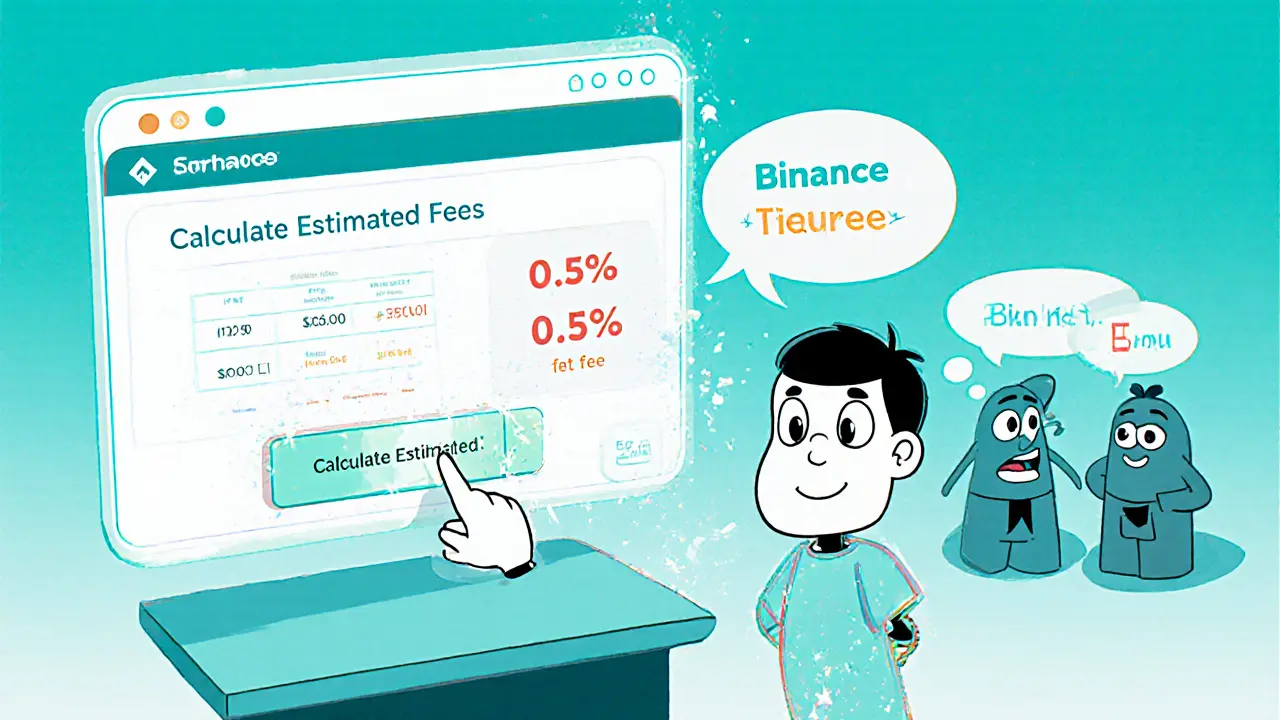Posted By Tristan Valehart On 12 Feb 2025 Comments (7)

Upbit Exchange Fee Calculator
Estimate Your Trading Costs on Upbit
Upbit charges a flat 0.25% fee per trade. Enter your estimated monthly trading volume to see potential costs.
Estimated Monthly Trading Costs
This estimate assumes a flat 0.25% fee rate on all trades. Actual costs may vary based on market conditions and trading frequency.
Upbit vs. Competitors Fee Comparison
Fee Comparison Table
| Feature | Upbit | Binance | Bithumb |
|---|---|---|---|
| Number of listed assets | 150+ | 600+ | 120+ |
| Trading fee (flat) | 0.25% | 0.10% maker / 0.12% taker | 0.15% maker / 0.20% taker |
| Deposit methods | Wire transfer only | Bank, credit card, crypto | Bank, crypto |
| Security certifications | ISO 27001, 27017, 27018 | ISO 27001 (partial) | None publicly listed |
| Mobile app rating (Google) | 3.2/5 | 4.5/5 | 3.8/5 |
Upbit is a South Korean cryptocurrency exchange launched in October 2017 by Dunamu. Built on the backbone of a company that once ran large‑scale stock‑trading systems, the platform offers institutional‑grade security, a flat 0.25% fee, and more than 150 digital assets across 158 trading pairs. In 2025 it remains one of the biggest players in Asia while expanding globally through Upbit Global and Upbit Singapore.
Key Takeaways
- Upbit supports over 150 cryptocurrencies with a flat 0.25% trading fee.
- Security is a top priority: ISO27001, ISO27017 and ISO27018 certifications, plus 24/7 monitoring.
- Deposits are limited to wire transfers; no credit‑card or instant‑payment options.
- Mobile app has 100,000+ downloads but a modest 3.2‑star rating.
- Best for users who value compliance and safety over ultra‑low fees.
Platform Overview
Upbit’s interface is clean and splits the dashboard into three main tabs: Spot Trading, Order History, and Funds. The design mirrors traditional stock‑trading platforms, which makes the learning curve gentle for anyone with a basic grasp of market mechanics. The exchange offers both spot and a limited set of futures contracts, but it does not provide advanced features like margin trading or a built‑in lending market.
Geographically, Upbit operates three regulated entities: the domestic South Korean exchange, Upbit Global (serving the rest of the world), and Upbit Singapore, each compliant with local AML/KYC requirements. This multi‑jurisdictional approach lets users trade the same order book while staying within the legal framework of their residence.
Security & Compliance
Security is where Upbit truly shines. The platform holds three ISO certifications-ISO27001 (information security management), ISO27017 (cloud security), and ISO27018 (privacy protection for personally identifiable information). These standards are audited annually, ensuring that both the backend infrastructure and the custody solutions meet enterprise‑grade expectations.
In practice, Upbit runs a 24/7 security operations center, employs hardware security modules (HSMs) for private key storage, and runs a bug‑bounty program that pays out up to 200BTC for critical vulnerabilities. After the 2019 hack that resulted in the loss of 342,000ETH, the exchange fully compensated affected users and tightened its internal controls, regaining most of the trust it had lost.
Fee Structure
Upbit’s fee model is simple: a flat 0.25% per trade, regardless of maker or taker status. While this transparency is appreciated by casual traders, high‑volume users may find it pricey compared to tiered structures elsewhere. For example, Binance charges as low as 0.02% for makers with high volume, and Bithumb offers a 0.11% maker fee for Korean residents.
Withdrawal fees are cryptocurrency‑specific. Bitcoin withdrawals cost 0.0005BTC per transaction-slightly below the global average of 0.00053BTC. Other coins follow a similar pattern: Ethereum withdrawal is 0.005ETH, and stablecoins typically cost $5‑$10 worth of the token.

Asset Selection & Trading Features
With more than 150 listed assets, Upbit outpaces many regional competitors. Popular coins like Bitcoin (Bitcoin), Ethereum, and Ripple are all available, alongside a broad range of DeFi tokens, NFTs, and newer Layer‑2 solutions. The exchange updates its listings quarterly, adding promising projects after a rigorous compliance review.
Trading tools are straightforward: limit orders, market orders, and stop‑limit orders are all supported. There’s no built‑in charting suite; users typically rely on external platforms such as TradingView for technical analysis. The lack of advanced order types (e.g., iceberg, TWAP) makes Upbit less appealing for algorithmic traders.
User Experience & Mobile App
The web UI is responsive and loads quickly even on slower connections. New users appreciate the “Quick Trade” widget that lets you buy a crypto with a single click after completing KYC. Customer support is reachable via live chat, email, and a regional phone line in South Korea; average response time is under 2hours during business days.
Upbit’s mobile app, available on Android and iOS, mirrors the desktop experience. It supports full order placement, portfolio tracking, and push notifications for price alerts. Despite the solid functionality, the app’s 3.2‑star rating reflects complaints about occasional lag and a clunky navigation flow for less‑tech‑savvy users.
How to Get Started
- Visit the official Upbit website and click “Register”.
- Enter your email and create a strong password.
- Complete the KYC process: upload a government‑issued ID, a selfie, and proof of address. Verification typically takes 1‑3 business days.
- Deposit funds via wire transfer. International users must use the SWIFT network; the minimum deposit is $100 USD.
- Navigate to the “Spot Trading” tab, select a pair (e.g., BTC/KRW), set your order type, and hit “Buy” or “Sell”.
For mobile‑first traders, download the Upbit Global app from Google Play or the App Store, log in with the same credentials, and repeat the above steps.
Pros & Cons
- Pros
- ISO‑certified security infrastructure.
- Wide selection of assets (>150).
- Regulatory compliance across multiple jurisdictions.
- Simple flat fee - easy to understand.
- Institutional‑grade custody for large holders.
- Cons
- Higher flat fee compared to tiered competitors.
- No credit‑card or instant‑payment deposits.
- Limited advanced trading tools.
- Mobile app rating indicates occasional performance issues.
- Withdrawal delays reported during peak traffic.
Comparison Table
| Feature | Upbit | Binance | Bithumb |
|---|---|---|---|
| Number of listed assets | 150+ | 600+ | 120+ |
| Trading fee (flat) | 0.25% | 0.10% maker / 0.12% taker | 0.15% maker / 0.20% taker |
| Deposit methods | Wire transfer only | Bank, credit card, crypto | Bank, crypto |
| Security certifications | ISO27001,27017,27018 | ISO27001 (partial) | None publicly listed |
| Mobile app rating (Google) | 3.2/5 | 4.5/5 | 3.8/5 |

Frequently Asked Questions
Is Upbit safe for large institutional funds?
Yes. Upbit’s ISO‑certified security framework, 24/7 monitoring, and hardware‑based custody make it one of the most secure exchanges for institutional investors.
Can I buy crypto with a credit card on Upbit?
No. Upbit only accepts wire transfers for fiat deposits. Credit‑card purchases are available on some competitors like Binance.
How long does KYC verification take?
Typically 1‑3 business days, though peak periods can extend the process to a week.
What are the Bitcoin withdrawal fees?
Upbit charges 0.0005BTC per withdrawal, marginally lower than the global average of 0.00053BTC.
Is there a mobile app for Upbit Global?
Yes, the Upbit Global app is available on Android and iOS, offering full spot‑trading functionality.


sundar M
October 3, 2025 AT 20:51Man, Upbit’s security setup is next level-ISO 27001, 27017, 27018? That’s more certs than my bank has. I’ve used Binance for years but after hearing about their past leaks, I’m seriously considering switching. The fact they compensated users after the 2019 hack? That’s rare. Most exchanges just ghost you.
Peter Schwalm
October 4, 2025 AT 20:28Agreed. Upbit’s not for day traders chasing 0.01% fees, but if you’re holding long-term or managing institutional funds, safety > savings. Their HSMs and bug bounty program show they’re not cutting corners. I’ve seen too many ‘decentralized’ platforms get hacked and vanish-this one feels like a fortress.
Ralph Nicolay
October 4, 2025 AT 20:47While the security posture is commendable, the flat 0.25% fee structure is economically indefensible for any non-retail participant. The absence of tiered pricing renders this platform incompatible with professional trading workflows. Furthermore, the exclusive reliance on wire transfers constitutes a regulatory bottleneck, not a feature.
Sonu Singh
October 5, 2025 AT 11:00lol i tried upbit last month and the app kept crashing when i tried to sell my shiba. had to use web version. also the kyc took 5 days even though i sent everything right. but hey at least my coins didnt get stolen 😅
Marianne Sivertsen
October 6, 2025 AT 02:13It’s interesting how Upbit prioritizes compliance over convenience. Most exchanges chase users with credit card deposits and flashy UIs, but Upbit’s quietly building trust. I don’t need instant buys-I need to sleep at night knowing my assets are locked down like a vault. Sometimes the boring choice is the smart one.
Nick Carey
October 6, 2025 AT 02:160.25%? Bro, I can get 0.02% on Binance. This feels like paying $10 for a cup of coffee when the gas station down the street sells it for $2. And no credit cards? In 2025? What is this, 2017?
Alex Horville
October 6, 2025 AT 22:29Upbit’s the only exchange that actually respects regulations. Binance’s a free-for-all with offshore shells. If you’re American, you want this. No drama. No sketchy jurisdictions. Just clean, legal, audited crypto. Stop whining about fees-security isn’t cheap, and neither is staying out of jail.